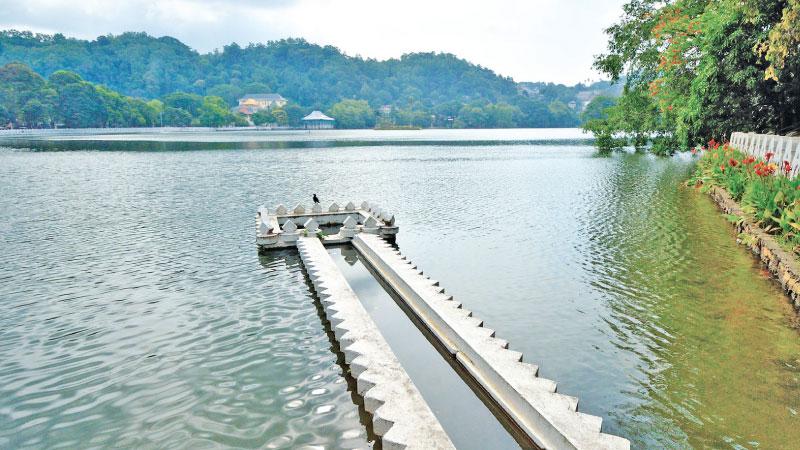
The magnificent man-made Kandy Lake, the ‘Milky Sea’ is at the heart of the hill country town of Kandy, ringed by a leafy promenade. We walk along the promenade of Kandy Lake, a walk in the footsteps of a great civilisation.
Shutterbugs always love water and light. Perhaps, it is a combination of a poetic expression for them. For me, it is a painting. In fact, the Kandy Lake is a fascinating location for those who look for the visual impact of Nature and its riches. It is also an ideal spot to escape from the monotony of life.
Recently, we were in Kandy to document one of the city’s landmark features, the Kandy Lake, and spent half a day just walking and gazing at this enchanting man-made body of water, absorbing the hustle and bustle of daily life around it.
A crowd of noisy devotees clad in white, after venerating the Sacred Tooth Relic of Buddha at Sri Dalada Maligawa (Temple of the Tooth Relic) and Bhikkus in saffron- robes attracted our attention. Unable to resist the temptation, I grasped my camera and began to walk along the promenade around the Kandy Lake, eager to capture the life around me. We soon found ourselves walking around under the lush green foliage of the serene lake’s fenced promenade towards Sri Sangaraja Mawatha.
Next, we reached the middle of the promenade and sat for a while, on a bench dotted with crow droppings. This is where most of the visitors to this historic city pause and relax to take in the beauty of the Lake, the bustling city on the periphery and the tranquility of the Maligawa.
Business for the vendors is always brisk here, everything from lotteries to toys and chick peas and raw mangoes, snapped up with delight. But what attracts attention is the people - foreign tourists, vendors, children, young couples, bhikkus and women of various ages clad in Kandyan sarees to stylish garments, strolling serenely beside the Walakulu Bemma, or the ‘cloud wall’. The parapet wall is modelled to resemble clouds and waves. The Walakulu Bemma, the main landmark of Kandy and its design is so well crafted that it greatly enhances the scenic appeal of the Lake.
We walked further up under the shady trees that led to Sangaraja Mawatha where we glimpsed the Malwatta Vihara overlooking the Lake. Bhikkus walked briskly to the temple through the promenade of the Lake. From Sangaraja Mawatha, the majestic Sri Dalada Maligawa and the lush greenery of Udawattekele forest reserve impart a serene setting for the Lake. It is hard to tear your eyes away from this picturesque scene.
A busy promenade circles the Lake allowing visitors to stumble upon several historical monuments, the most interesting being the Ulpange or ‘Queens bathing pavilion’, located partly in the waters of the Lake. The king and his wives are believed to have used the pavilion when bathing in the Lake and the building has the characteristics of Kandyan architecture with rounded columns. Some of the old colonial architectural buildings such as, Hotel Suisse and Queen’s Hotel stand majestically near the Lake.
The Kandy Lake was the greatest creation of the last King of Kandy, Sri Wickrama Rajasinghe (1798-1815). Built at a staggering cost and with enormous effort, it transformed the capital into a place of beauty. He called it ‘Kiri Muhuda’ or Milky Sea. On the small island in the middle of the Lake, the King built a pleasure house, where some say he kept his harem, but today, it is a small well-maintained flower garden and plays host to various kinds of birds.The Lake was built in 1807. The extent of the Kandy Lake is 6,544sq. metres and the circumference, 3.21 km .
However, the city of Kandy, built to harmonise with Nature, stands out like a sore thumb amid unplanned modern development, oozing out in all directions. The massive trees that once adorned the hills are disappearing day by day, allowing the concrete jungle to encroach the hilltop.
The Kandy Lake is a magnificent legacy that speaks of a bygone era and transforms the hill capital into a place of beauty. But some of the springs which once fed the lake are drying up and many of them are blocked due to rapid development. If the situation is allowed to continue, the beauty of the Kandy Lake will only be a memory.

